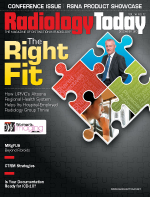 December 2013
December 2013
Cloud-Based CT Dose Monitoring
By David Yeager
Radiology Today
Vol. 14 No. 12 P. 10
Dose tracking for radiology exams is considered a good idea but not a lot of facilities are doing it, mainly because it can be a cumbersome process. But with increased attention from the public and the government, it’s shifting from a goal to a necessity. The continuing emphasis on patient-centered care is one reason. Upcoming physician quality reporting system requirements is another; starting in 2014, radiologists can report on optimizing patient exposure to ionizing radiation, primarily from CT.
A study in the September issue of the Journal of the American College of Radiology surveyed the essential components of a comprehensive dose-reporting strategy for CT and introduced a cloud-based hybrid model dose-tracking system. Lead author Ronak K. Talati, MD, a radiologist at Stony Brook University Medical Center in New York, says there are business and technical challenges involved with implementing a dose-tracking system. The key to overcoming them, he says, is to start thinking about dose tracking in a systematic way.
On the technical side, the article outlines several crucial aspects of dose tracking. The first is dose capture. Although DICOM structured reporting (SR) stores dose data in numerical form, CT scanners that aren’t DICOM-SR–enabled store dose information on dose sheets, which store the data as images—pixels, not numbers—in PACS. Capturing data from those dose sheets requires an optical character recognition algorithm.
Once the data are captured, they must be converted to a form that can be compared with baseline data and indexed against similar CT scans to help the institution optimize radiation dose. The data need to be associated with the patient and communicated to referring physicians. Finally, the information must be exportable to dose registries, such as the ACR’s Dose Index Registry, so it can be used to compile geographic dose data and develop benchmarks for participating institutions.
Talati says one difficulty with the ACR dose registry is that it’s difficult to use. Small differences in naming exams can significantly skew the results. The ACR is using the RadLex Playbook to help smooth out variations in exam names, but adoption has been slow.
On the business side, institutions can choose from a range of commercial dose-tracking systems or develop their own. Systems that are easy to integrate into a department’s workflow tend to be expensive, while inexpensive systems tend to require significant customization. Do-it-yourself systems often need the most manpower and money. Talati says institutions, whether large or small, must figure out what their return on investment is before implementing a dose-tracking system.
To address these challenges, Stony Brook University Medical Center, with a grant from Toshiba, developed a cloud-based hybrid dose-tracking system called Scannerside, which has been running for about one year. It’s a live dose registry and is updated in real time. It’s geared toward technologists’ workflow and provides effective dose, dose-length product, and CT dose index information 30 to 40 seconds after an exam is performed. The technologist receives immediate feedback about how the exam dose compares with similar exams, prints out dose information for the patient, and the dose information is uploaded to the radiology report through the application programming interface of the institution’s choosing.
Scannerside uses a facility’s existing hardware and is implemented with server notes. It uses a memory cache system similar to Facebook’s for storing the information. Exam processing is done at the network level at the client’s facility, and the relevant data from the exam are sent to Scannerside’s servers. The dose information then is extracted and returned to the facility. Talati, a codeveloper of Scannerside, says this setup especially is convenient for large institutions or radiology groups with multiple offices. Currently, Scannerside has approximately 300,000 CT exams from across the country in its database, but Talati says it has the capacity to process hundreds of scans per minute and 5 million to 6 million per year.
Educational Value
An interesting trend that the study’s authors have noted is Scannerside’s effect on patients. Although there has been some concern in the radiology community that providing dose information may drive down repeat imaging rates, Talati says he’s seen no evidence of that. In fact, Stony Brook University Medical Center has seen an increase in repeat imaging since it started providing dose information to patients. “The repeat rate is unbelievable. We’ve seen 20% to 30% growth in a couple of months,” Talati says. “We’ve seen referring clinicians asking patients to drive all the way down Long Island to get exams at a specific site because they’ve heard that we educate patients on this. It was a surprise to us. We didn’t expect it. We actually expected that we would scare people.”
Along with dose information, Scannerside’s materials explain to patients that dose is cumulative and advises them to return to the facility if they need additional imaging so that their cumulative dose can be tracked. Talati says today’s patients also are more likely to research what their results mean, and he believes this trend is a sign of greater patient involvement. He and his colleagues plan to release a follow-up study that provides more detail about this phenomenon.
Although various government agencies likely will require dose tracking in some form, Talati says patient education may be the best reason to start dose monitoring. He sees patient education as a growth area for radiology. Turning it into a positive is one way that radiology can increase its value.
“It’s becoming a hot topic now,” Talati says. “And I think it’s very important for us, as a radiology community, to be vocal about radiation dose. We need to be at the forefront of educating the public.”
— David Yeager is a freelance writer and editor based in Royersford, Pennsylvania. He writes primarily about imaging informatics topics for Radiology Today.

